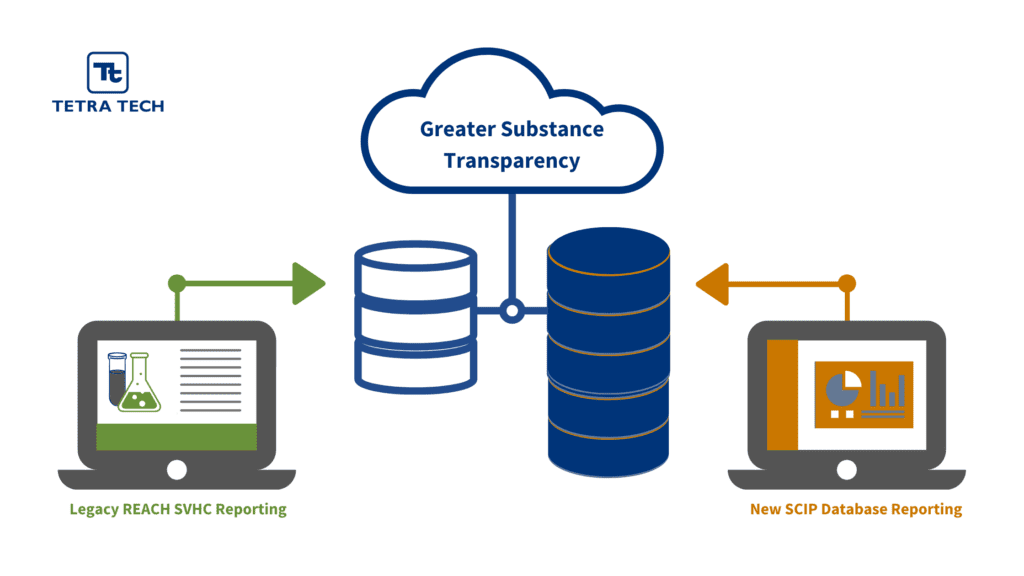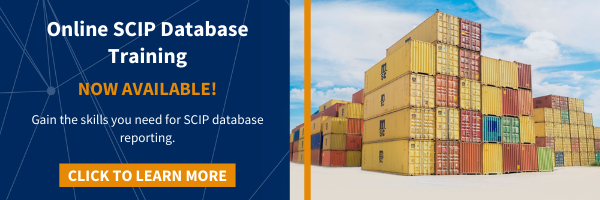The Substances of Concern in Products (SCIP) database is a new requirement from the European Chemical Agency (ECHA) that commences January 5, 2021. The database is part of the European Union’s (EU) Waste Framework Directive (WFD), which requires reporting for Substances of Very High Concern (SVHCs).
REACH currently requires companies to report SVHCs in products to their customers, if those SVHCs reach the 0.1% threshold within any article of the product. Therefore, the reporting requirements for SCIP are not entirely new — however, the SCIP database requires additional reporting and oversight.

What New Requirements Does the SCIP Database Introduce?
Reporting Enforcement and Transparency
REACH SVHC requirements already specify that chemicals be reported to customers — but not necessarily to EU regulators. With the SCIP database, EU regulators will be able to audit and enforce the reporting requirements more easily than they could under the REACH SVHC reporting regime, which lacked any central database.
EU regulators will then make the vast majority of the information in the SCIP database searchable to any interested stakeholder, even outside of the EU. REACH SVHC communications are not required to be published online in a publicly accessible database, so the SCIP database will bring a major change in transparency.
However, this also presents numerous confidentiality concerns. But, if information is entered correctly, confidential and proprietary information can be hidden from the public.
Consistent Reporting Format
The SCIP database will also create a consistent format for SVHC reporting. The REACH regulation provides very broad parameters for how SVHC reporting should be conducted but with almost no specifics on the precise format. Therefore, REACH SVHC communications have been handled inconsistently, with customers and suppliers agreeing on mutually acceptable formats.
The SCIP database will use a standardized format with defined fields and rigorous protocols for data transfer and submissions. This creates a need for a structured approach, and companies will likely need to invest in user training, account administration, security management and other related efforts to meet SCIP requirements.
Additional SCIP Database Requirements
The SCIP database will have additional information requirements beyond those already existing for REACH SVHC reporting.
For example, TARIC codes will be required to identify the product categories and uses. This will necessitate an organized effort to solicit new data from your supply chain, as most of it has not been reported during REACH SVHC efforts.
What Will Be the Impact of the SCIP Database?
As we have seen, the SCIP database will change many things:
- Presenting increased risks to proprietary business information.
- Facilitating stronger regulatory enforcement ability.
- Creating a need for trained internal resources to conduct data entry, and manage user accounts and security concerns.
- Requiring new data that has not been collected and reported by most companies.
- Increasing supply chain requirements, meaning you will need to educate your suppliers on the new data fields and how they can report them to you.
Given these impacts, it is not surprising that some industry group sources have predicted that the SCIP database may end up being the world’s largest database and may cost industry up to USD $90 billion annually. And even these predictions assume that the EU does not follow its customary course of ramping up the scope and scale of its new regulations after they have entered into enforcement.
Whether these predictions prove accurate or not, SCIP will still have a large impact across the globe. On September 21, 2020, a coalition of 40 industry groups asked the EU Commission president to “take urgent political action” and delay the January 5, 2021, implementation date. The EU Commission reply stated that SCIP was not going away, and pointed out that the clock has been ticking since May 2018, when the requirement was first adopted.
Prepare for SCIP Requirements Now
Now is the time to prepare your roadmap for transitioning data to the SCIP database so you can keep your products compliant and avoid reporting redundancies that could occur if you overlook the data you already have at your fingertips.
For support, contact Tetra Tech at [email protected]. We can help you prepare for SCIP reporting requirements, from helping you survey your supply chain to advising you in best practices that are emerging for this new requirement. We also provide online SCIP training that can equip your compliance team with the expertise they need for effective SCIP database reporting.







